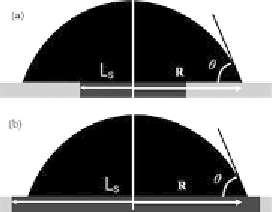Biomedical Engineering Reference
In-Depth Information
Figure 2.
Droplet on a heated substrate for two different sizes of the heater (in dark gray). In (a) the
heater is smaller than the contact radius (
L
s
<R
) while in (b) it is larger (
L
s
>R
). The contact angle
θ
, contact radius
R
are also represented as well as the symmetry axis (white vertical line).
Figure 3.
Substrate characteristics. The heated zone (substrate heater) is at temperature
T
s
and is
represented in black.
in the understanding of the hydrodynamics inside the droplets as will be illustrated
below.
Due to the spherical cap geometry of the droplets and their pinned dynamics,
mechanisms including the contact line dynamics and Van der Waals forces acting
between water and the substrate do not have to be explicitly described here. De-
pinning or receding contact lines situations will also run out of the scope of the
present chapter [25, 30]. As we aim to describe here the droplet hydrodynamics, it
results here that Navier-Stokes and heat equations for incompressible viscous fluid
will be sufficient for our purpose [23, 66]. Boussinesq approximation is another
important simplification that will be used. It was discussed above that its use is justi-
fied by the temperature differences that are too small to generate significant changes
in the thermodynamic properties (density, heat conductivity, dynamic viscosity) of
water. As only pinned droplets will be considered
R
is fixed. Finally, water evapora-
tion is assumed to be a slow process when compared to the equilibration time at the
water/air interface. One direct consequence of these approximations is that partial
derivatives with respect to time can be neglected in both Navier-Stokes and heat
equations. In this latter, viscous dissipative contributions will also be neglected. In
this context water circulation and heat transfer inside the droplet can be described
by the two stationary equations [67]:
(v
•
grad
)v
=
νv,
(1)
(v
•
grad
)T
=
kT,
(2)
where
ν
(resp.,
k
) is the kinematic viscosity (resp., thermal diffusivity) of liquid
water.


Search WWH ::

Custom Search